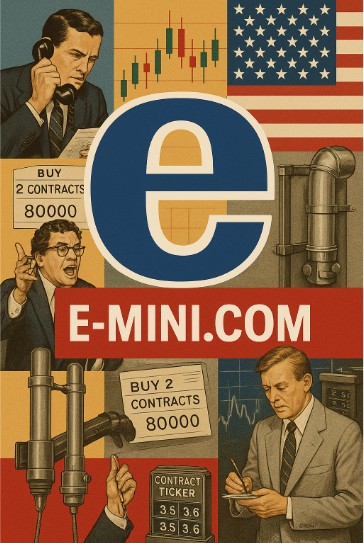What Are E-Mini Futures?
E-mini futures, often referred to simply as “E-minis,” are electronically traded futures contracts that represent a fraction of the value of corresponding standard futures contracts. They were introduced by the Chicago Mercantile Exchange (CME) in 1997, with the launch of the E-mini S&P 500 futures. Since then, E-mini futures have gained popularity among traders due to their accessibility, liquidity, and lower margin requirements compared to full-sized contracts.
E-mini futures contracts are designed to provide exposure to a specific market index or asset class in a smaller, more manageable size. These contracts cover various asset classes, including equity indices, commodities, and currencies. The most widely traded E-mini futures contracts include:
- E-mini S&P 500 (ES): Tracks the S&P 500 Index, representing 500 large-cap U.S. stocks.
- E-mini Nasdaq-100 (NQ): Tracks the Nasdaq-100 Index, representing 100 of the largest non-financial companies listed on the Nasdaq Stock Market.
- E-mini Dow Jones Industrial Average (YM): Tracks the Dow Jones Industrial Average, representing 30 large publicly-owned companies based in the United States.
- E-mini Russell 2000 (RTY): Tracks the Russell 2000 Index, representing 2000 small-cap U.S. stocks.
Advantages of Trading E-Mini Futures
E-mini futures offer several advantages for traders:
- Liquidity: E-mini futures are highly liquid, meaning there is a large volume of contracts traded daily. This high liquidity ensures that traders can enter and exit positions with minimal slippage.
- Leverage: Futures contracts allow traders to control a large notional value with a relatively small initial margin. This leverage can amplify profits but also increases the potential for losses.
- Lower Capital Requirements: Compared to full-sized futures contracts, E-mini futures require lower initial margin deposits, making them accessible to a wider range of traders.
- Diversification: E-mini futures provide exposure to a broad range of asset classes and indices, allowing traders to diversify their portfolios.
- Extended Trading Hours: E-mini futures trade nearly 24 hours a day, providing greater flexibility for traders to respond to global market events.
Getting Started with E-Mini Futures Trading
Setting Up Your Trading Account
To trade E-mini futures, you’ll need to open an account with a futures broker. Here are the key steps:
- Choose a Broker: Select a reputable futures broker that offers access to E-mini futures markets. Look for brokers that provide robust trading platforms, competitive commissions, and strong customer support.
- Complete the Application: Fill out the broker’s application form, providing necessary personal and financial information. You’ll also need to agree to the broker’s terms and conditions.
- Fund Your Account: Deposit funds into your trading account. Ensure you meet the minimum deposit requirements set by the broker.
- Familiarize Yourself with the Platform: Spend time learning how to use the broker’s trading platform. Most brokers offer demo accounts where you can practice trading without risking real money.
Understanding E-Mini Futures Contracts
Before placing your first trade, it’s crucial to understand the specifications of E-mini futures contracts. Key contract specifications include:
- Contract Size: The notional value of the contract, which varies depending on the underlying index or asset.
- Tick Size: The minimum price movement of the contract. For example, the E-mini S&P 500 futures have a tick size of 0.25 index points, equivalent to $12.50 per contract.
- Trading Hours: The hours during which the contract can be traded. E-mini futures typically trade nearly 24 hours a day, five days a week.
- Expiration Date: The date on which the contract expires. E-mini futures contracts have quarterly expiration dates (March, June, September, and December).
Strategies for Trading E-Mini Futures
Day Trading
Day trading involves opening and closing positions within the same trading day, with the goal of profiting from short-term price movements. Key day trading strategies for E-mini futures include:
- Scalping: This strategy involves making numerous small trades to capture minor price fluctuations. Scalpers typically hold positions for just a few seconds to a few minutes.
- Momentum Trading: Momentum traders aim to capitalize on strong price movements in the direction of the prevailing trend. They look for high-volume trades and breakouts from key levels of support or resistance.
- Range Trading: Range traders identify price ranges within which an E-mini contract is trading and attempt to buy at the lower end of the range and sell at the upper end.
Swing Trading
Swing trading involves holding positions for several days to weeks, aiming to profit from medium-term price movements. Swing traders often use technical analysis to identify trends and reversals. Key swing trading strategies include:
- Trend Following: This strategy involves identifying and trading in the direction of the prevailing trend. Traders use moving averages and other trend indicators to determine entry and exit points.
- Reversal Trading: Reversal traders look for signs that a current trend is about to reverse. They use technical indicators such as the Relative Strength Index (RSI) and moving average convergence divergence (MACD) to identify potential reversal points.
Position Trading
Position trading involves holding positions for several weeks to months, aiming to profit from long-term trends. Position traders often use fundamental analysis in addition to technical analysis. Key position trading strategies include:
- Fundamental Analysis: This strategy involves analyzing economic indicators, earnings reports, and other fundamental data to make long-term trading decisions.
- Technical Analysis: Position traders also use technical analysis to identify long-term trends and potential entry and exit points.
Risk Management in E-Mini Futures Trading
Effective risk management is crucial for long-term success in E-mini futures trading. Key risk management techniques include:
- Setting Stop-Loss Orders: A stop-loss order is an order to sell a position when it reaches a certain price, limiting potential losses. Always use stop-loss orders to protect your capital.
- Position Sizing: Determine the appropriate position size based on your risk tolerance and account size. Never risk more than a small percentage of your account on a single trade.
- Diversification: Diversify your trades across different E-mini contracts and asset classes to reduce risk.
- Regular Review: Regularly review your trading performance and adjust your strategies as needed. Keep a trading journal to track your trades and identify areas for improvement.
E-mini futures trading offers numerous opportunities for traders of all levels. With lower capital requirements, high liquidity, and extended trading hours, E-mini futures provide a versatile and accessible way to participate in the futures markets. By understanding the contract specifications, implementing effective trading strategies, and practicing sound risk management, you can navigate the exciting world of E-mini futures trading with confidence. Whether you’re a day trader, swing trader, or position trader, E-mini futures can be a valuable addition to your trading arsenal.
Ready to start trading futures? Call US 1(800)454-9572 – Int’l (310)859-9572 email info@e-mini.com and speak to one of our experienced, Series-3 licensed futures brokers and start your futures trading journey with E-Mini.com today.
Disclaimer – Trading Futures, Options on Futures, and retail off-exchange foreign currency transactions involves substantial risk of loss and is not suitable for all investors. Past performance is not indicative of future results. You should carefully consider whether trading is suitable for you in light of your circumstances, knowledge, and financial resources. You may lose all or more of your initial investment. Opinions, market data, and recommendations are subject to change at any time.
Important: Trading commodity futures and options involves a substantial risk of loss. The recommendations contained in this writing are of opinion only and do not guarantee any profits. This writing is for educational purposes. Past performances are not necessarily indicative of future results.
**This article has been generated with the help of AI Technology. It has been modified from the original draft for accuracy and compliance.
***@cannontrading on all socials.




